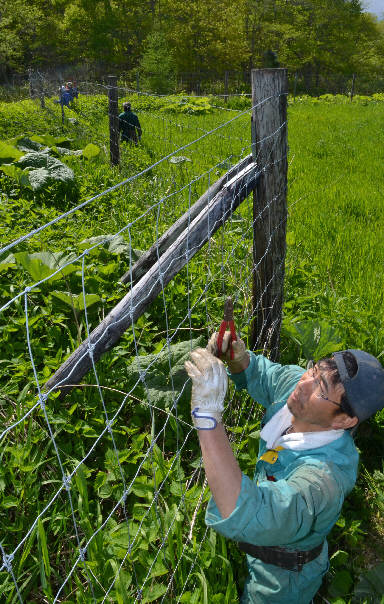
A dairy farmer repairs the ripped fences in Shiranuka, Hokkaido. Monitoring and maintenance of fences are conducted twice a year in the district.
Farmers’ efforts to prevent crop raiding by wild animals have often ended in vain despite a large amount of public funds and manpower put into them. The Japan Agricultural News reports on farmers in Hokkaido troubled by wild deer.
Thousands of kilometers of deer prevention fences, dubbed the “Great Wall of China,” are stretched around farmlands in the eastern part of Hokkaido. In Watenbetsu district of Shiranuka, Kazushi Ishiguro, a 58-year-old dairy farmer, is busy repairing the fences. “If you drive at night, you can see a herd of 20 to 30 deer lit up by headlights,” Ishiguro says. The deer enter farmlands through broken-down fences and settle down. Although a great amount of money and efforts were put into setting up fences, farmers are having a hard time maintaining them properly.
In the five years until fiscal 2000, Shiranuka town spent 655 million yen for public works projects to set up 89 kilometers of iron fences and 240 kilometers of pasture fences with electric wires equipped on the upper part. As a result, damages on farmland such as pasture grasses, which used to mark 100 million yen a year, were reduced to 78 million yen in fiscal 2005. However, the effects did not last long. Damages soared again to 180 million in fiscal 2011.
Iron fences with a total length of 52 kilometers surround the mountainous district of Watenbetsu where dairy farming is widely practiced. Ishiguro, who maintains more than 20 kilometers of the fences with three other farmers, says with a bitter smile that they feel hopeless when they realize deer are actually breeding inside the fences.
Underbrush often covers electric fences, causing short circuits and rendering the fences useless, making it easy for deer to go over them in many places. Farmers organized a cooperative association to repair the fences, but as the number of farms is decreasing and each firm’s business is expanding, it is becoming more difficult to secure manpower for maintenance, said an official of Shiranuka municipal government.
In Hokkaido, setting up of 2 to 2.5 meter-high net fences began mainly as public works projects firstly in the eastern districts in fiscal 1995. In fiscal 2003, the total length topped 3,000 kilometers. Many of the fences have reached the end of their service life and need resetting or repairing, according to Hokkaido prefectural government’s agricultural policy planning department.
Meanwhile, increasing requests for setting up of fences are also coming from the western districts of Hokkaido where the number of deer is soaring. Hokkaido prefectural government used grants provided by the national government under the act on special measures for prevention of damage related to agriculture, forestry and fisheries caused by wildlife to set up new fences. The prefectural government spent roughly 1 billion yen in fiscal 2012, but this was only 80% of the requested amount. In response to continuing demands for new fences, the prefectural government plans to spend some 1.3 billion yen in fiscal 2013 for measures related to deer damage management.
Deer damage to crops continues to be a headache for farmers in Hokkaido. The losses due to deer damage amounted to 6.2 billion yen in fiscal 2011, up 5% from the previous year, accounting for 30 percent of the total damage nationwide. Deer captured in Hokkaido in fiscal 2011 totaled 135,000, marking a 24% rise from a year before. The endless battle of maintaining the expanding fences, with the total length reaching the length of the Japanese archipelago, has failed to have a decisive impact on reducing the damage.
Hiroyuki Uno, chief researcher at Hokkaido Research Organization’s Institute of Environmental Sciences, noted the problem lies in the fact that the government placed priority on the setting up of fences and that the maintenance of fences was left to farmers’ own responsibility. In order to increase the damage-reducing effect with limited budget, it is necessary to foster manpower specializing in planning effective setting and management of fences, Uno stressed.
(June 18, 2013)

